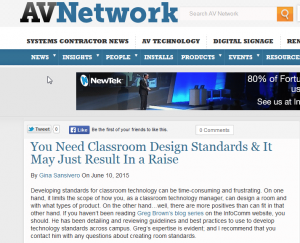 This post was originally published on AV Technology and avnetwork.com here: http://www.avnetwork.com/news/0006/you-need-classroom-design-standards-&-it-may-just-result-in-a-raise/95459
This post was originally published on AV Technology and avnetwork.com here: http://www.avnetwork.com/news/0006/you-need-classroom-design-standards-&-it-may-just-result-in-a-raise/95459
1) Reduces training time necessary for faculty and staff: Consistency across classrooms offers you the ability to train end users on equipment that they will see in every room, regardless of floor or building. Keeping in mind that classrooms of different sizes, uses and layouts will require different equipment, work on creating different tiers of standards. Keep a description of these standards in a location that is easily accessible for faculty and staff (school website?). This allows them to review the equipment and come to you with questions prior to the beginning of a class, rather than call you with an emergency 10 minutes after class begins. Don’t forget to keep the user interface of any control system consistent as well! Once they have been trained on the standard designs, they are less likely to have concerns about walking into almost any room on campus. Another plus: some manufacturers offer additional training sessions (considered professional development?) covering how to integrate their technology equipment into lesson plans.
2) Manages expectations of faculty: Similar to reducing the amount of time spent training instructors and staff, keeping consistency across campus allows you to manage the expectations that the users have of the capabilities of the technology in the classroom. This, in turn, offers the faculty the ability to tailor their instruction to the technology available. It also reduces the set-up time and embarrassing tech fails the instructors encounter at the beginning of class. Understanding what the technology can and cannot offer sets the stage for a more comfortable user experience.
3) Keeps student experience consistent: Understanding how and what type of material and media can or will be presented creates a comfortable and consistent experience for the students as well. Add to that reduced technology downtime, well trained teachers and seamless instruction and you have a student who may not be happy to have a stats class at 8pm on a Friday morning, but at least a less frustrated student. (Side note: Why are stats classes always the first thing on Friday mornings???!!!)
4) Reduces cost of and time required for equipment maintenance and downtime: When technicians (and student aids) are trained on a smaller variety of products, the downtime for maintenance and therefore cost of maintenance is significantly reduced. Additionally, it reduces the amount of different replacement parts that have to be kept in inventory (no department head likes money sitting on his/her shelves). It also allows for quicker troubleshooting and a better understanding of equipment “red flag notifiers” for preventative maintenance.
5) Eases budgetary strain: I am not sure there will ever be a fix for this, but standardizing on manufacturers and equipment may open the doors for quantity and loyalty discounts with some manufacturers and dealers. Saving on equipment costs may open up doors to money you never had before to try new products, give yourself a raise, or hire an outside installer to run cables and hang projectors.
With all of the increased productivity and efficiency you will experience by implementing standardized technology classroom designs, you will have more time on your hands to meet with manufacturers, learn about new products and break-through trends, stay current on your training and certifications, sleep, eat lunch (did you forget what a lunch break was?), spend time with the kids or even volunteer! What will you do with all your free time?
If I missed any benefits that you have experienced by designing standards for your technology rich classrooms, please let me know or add them in the comments section below.
